buttons SKODA OCTAVIA TOUR 2009 1.G / (1U) Owner's Manual
[x] Cancel search | Manufacturer: SKODA, Model Year: 2009, Model line: OCTAVIA TOUR, Model: SKODA OCTAVIA TOUR 2009 1.G / (1U)Pages: 224, PDF Size: 13.53 MB
Page 14 of 224
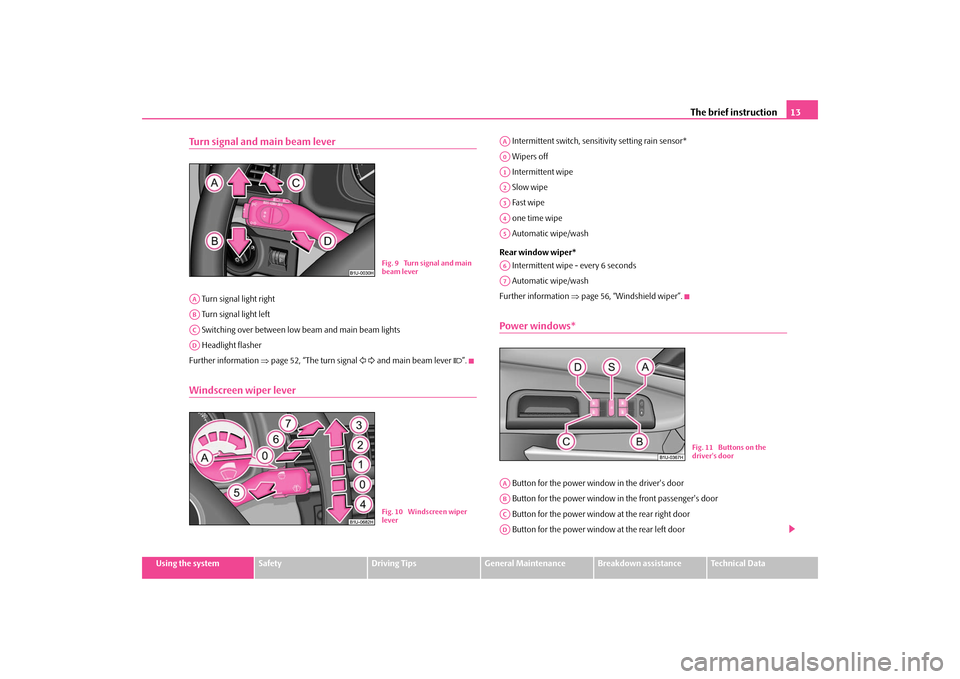
The brief instruction
13
Using the system
Safety
Driving Tips
General Maintenance
Breakdown assistance
Technical Data
Turn signal and main beam lever Turn signal light right Turn signal light left Switching over between low beam and main beam lights Headlight flasherFurther information
⇒page 52, “The turn signal
and main beam lever
”.
Windscreen wiper lever
Intermittent switch, sensitivity setting rain sensor* Wipers off Intermittent wipe Slow wipe Fast wipe one time wipe Automatic wipe/wash Rear window wiper* Intermittent wipe - every 6 seconds Automatic wipe/washFurther information
⇒page 56, “Windshield wiper”.
Power windows* Button for the power window in the driver's door Button for the power window in the front passenger's door Button for the power window at the rear right door Button for the power window at the rear left door
Fig. 9 Turn signal and main beam lever
AAABACAD
Fig. 10 Windscreen wiper lever
AAA0A1A2A3A4A5A6A7
Fig. 11 Buttons on the driver's door
AAABACAD
s2g8.b.book Page 13 Tuesday, April 7, 2009 8:53 AM
Page 15 of 224
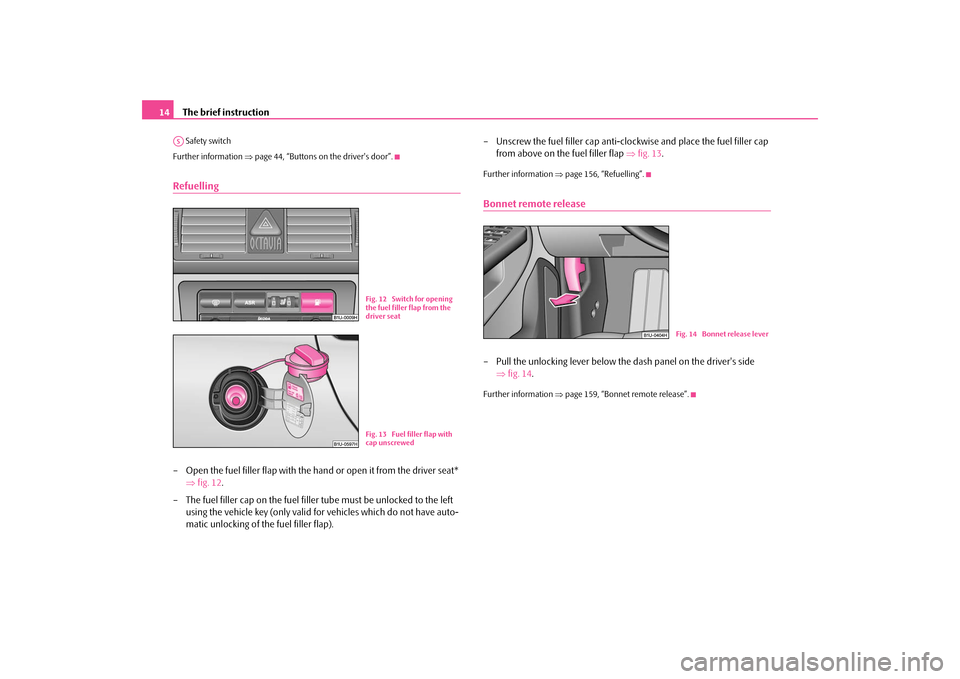
The brief instruction
14
Safety switch Further information
⇒page 44, “Buttons on the driver's door”.
Refuelling– Open the fuel filler flap with the hand or open it from the driver seat*
⇒
fig. 12
.
– The fuel filler cap on the fuel fille
r tube must be unlocked to the left
using the vehicle key (only valid for
vehicles which do not have auto-
matic unlocking of the fuel filler flap).
– Unscrew the fuel filler cap anti-clo
ckwise and place the fuel filler cap
from above on the fuel filler flap
⇒
fig. 13
.
Further information
⇒page 156, “Refuelling”.
Bonnet remote release– Pull the unlocking lever below the dash panel on the driver's side
⇒
fig. 14
.
Further information
⇒page 159, “Bonnet remote release”.
AS
Fig. 12 Switch for opening the fuel filler flap from the driver seatFig. 13 Fuel filler flap with cap unscrewed
Fig. 14 Bonnet release lever
s2g8.b.book Page 14 Tuesday, April 7, 2009 8:53 AM
Page 41 of 224
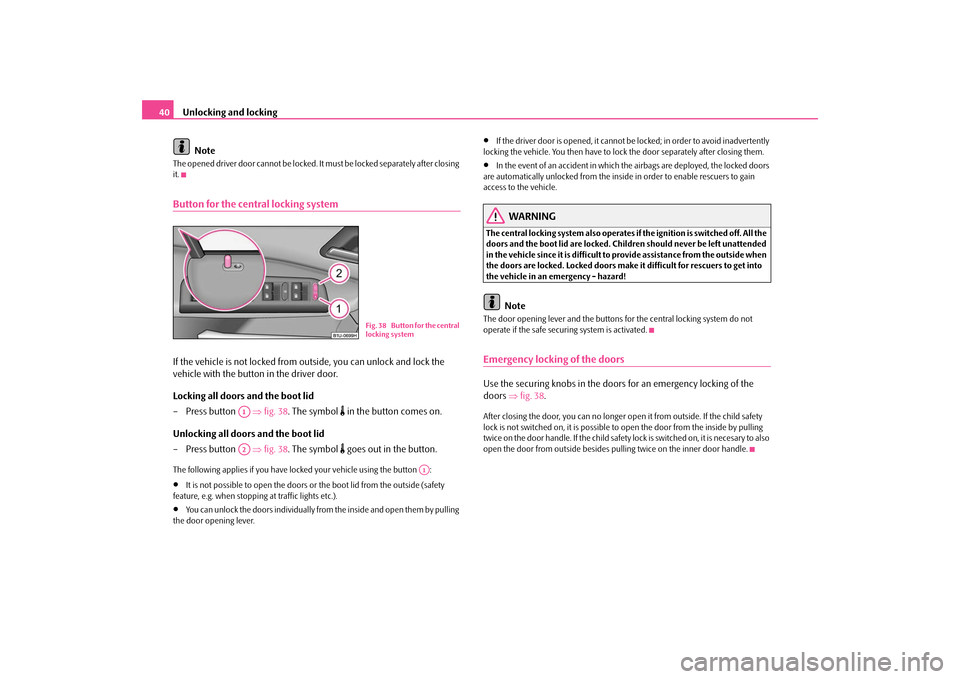
Unlocking and locking
40
Note
The opened driver door cannot be locked. It
must be locked sepa
rately after closing
it.Button for the central locking systemIf the vehicle is not locked from outside, you can unlock and lock the vehicle with the button in the driver door. Locking all doors and the boot lid – Press button
⇒
fig. 38
. The symbol
in the button comes on.
Unlocking all doors and the boot lid – Press button
⇒
fig. 38
. The symbol
goes out in the button.
The following applies if you have lo
cked your vehicle using the button :
•
It is not possible to open the doors or the boot lid from the outside (safety
feature, e.g. when stopping at traffic lights etc.).•
You can unlock the doors individually from the inside and open them by pulling
the door opening lever.
•
If the driver door is opened, it cannot
be locked; in order to avoid inadvertently
locking the vehicle. You then have to lock
the door separately
after closing them.
•
In the event of an accident in which the airbags are deployed, the locked doors
are automatically unlocked from the inside in order to enable rescuers to gain access to the vehicle.
WARNING
The central locking system al
so operates if the ignition is switched off. All the
doors and the boot lid are locked. Children should never be left unattended in the vehicle since it is difficult to
provide assistance from the outside when
the doors are locked. Locked doors make it difficult for rescuers to get into the vehicle in an emergency - hazard!
Note
The door opening lever and the buttons for the central locking system do not operate if the safe securing system is activated.Emergency locking of the doorsUse the securing knobs in the doors for an emergency locking of the doors
⇒
fig. 38
.
After closing the door, you can no longer open it from outside. If the child safety lock is not switched on, it is possible to
open the door from the inside by pulling
twice on the door handle. If the child safety lock is switched on, it is necesary to also open the door from outside besides pu
lling twice on the inner door handle.
Fig. 38 Button for the central locking system
A1A2
A1
s2g8.b.book Page 40 Tuesday, April 7, 2009 8:53 AM
Page 43 of 224
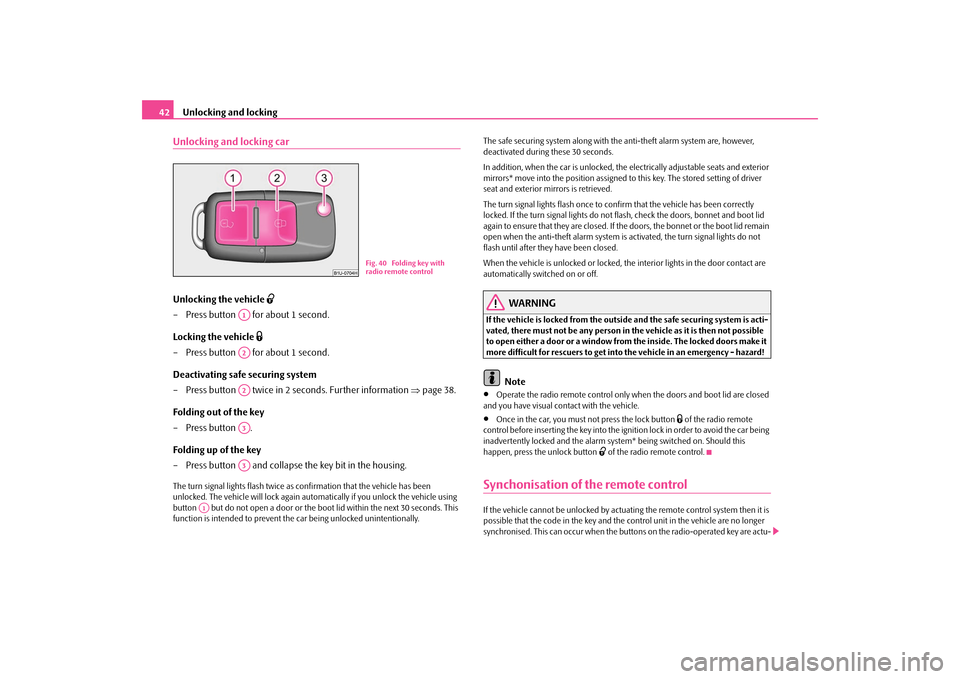
Unlocking and locking
42
Unlocking and locking carUnlocking the vehicle
– Press button for about 1 second. Locking the vehicle
– Press button for about 1 second.Deactivating safe securing system – Press button twice in 2 seconds. Further information
⇒
page 38.
Folding out of the key – Press button . Folding up of the key – Press button and collapse the key bit in the housing.The turn signal lights flash twice as
confirmation that the vehicle has been
unlocked. The vehicle will lock again auto
matically if you unlock the vehicle using
button but do not open a door or the
boot lid within the next 30 seconds. This
function is intended to prevent the car being unlocked unintentionally.
The safe securing system along with the anti-theft alarm system are, however, deactivated during these 30 seconds. In addition, when the car is unlocked, the el
ectrically adjustable seats and exterior
mirrors* move into the position assigned to this key. The stored setting of driver seat and exterior mirrors is retrieved. The turn signal lights flash once to co
nfirm that the vehicle has been correctly
locked. If the turn signal lights do not fl
ash, check the doors, bonnet and boot lid
again to ensure that they are closed. If th
e doors, the bonnet or the boot lid remain
open when the anti-theft alarm system is activated, the turn signal lights do not flash until after they have been closed. When the vehicle is unlocked or locked, the
interior lights in the door contact are
automatically switched on or off.
WARNING
If the vehicle is locked from the outsid
e and the safe securing system is acti-
vated, there must not be any person in the vehicle as it is then not possible to open either a door or a window from the inside. The locked doors make it more difficult for rescuers to get into
the vehicle in an emergency - hazard!
Note
•
Operate the radio remote control only when the doors and boot lid are closed
and you have visual co
ntact with the vehicle.
•
Once in the car, you must
not press the lock button
of the radio remote
control before inserting the key into the ignition lock in order to avoid the car being inadvertently locked and the alarm syst
em* being switched on. Should this
happen, press the unlock button
of the radio remote control.
Synchonisation of the remote controlIf the vehicle cannot be unlocked by actuatin
g the remote control system then it is
possible that the code in the key and the
control unit in the vehicle are no longer
synchronised. This can occur when the buttons on the radio-operated key are actu-
Fig. 40 Folding key with radio remote control
A1A2A2A3A3
A1
s2g8.b.book Page 42 Tuesday, April 7, 2009 8:53 AM
Page 45 of 224
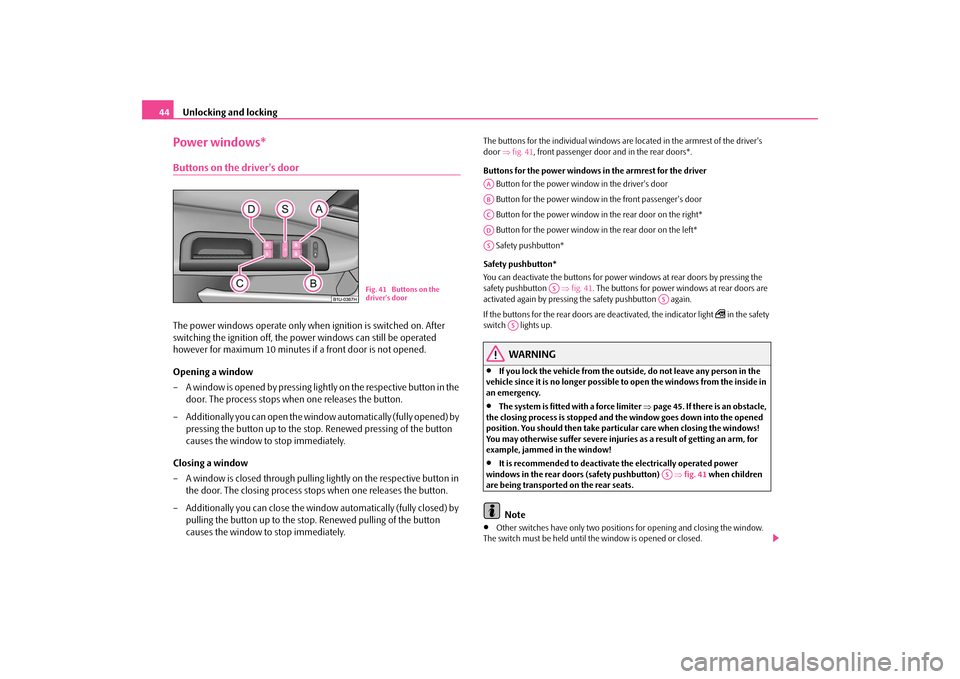
Unlocking and locking
44
Power windows*Buttons on the driver's doorThe power windows operate only when ignition is switched on. After switching the ignition off, the power windows can still be operated however for maximum 10 minutes if
a front door is not opened.
Opening a window – A window is opened by pressing lightly on the respective button in the
door. The process stops when one releases the button.
– Additionally you can open the window
automatically (fully opened) by
pressing the button up to the stop. Renewed pressing of the button causes the window to stop immediately.
Closing a window – A window is closed through pulling
lightly on the respective button in
the door. The closing process stops when one releases the button.
– Additionally you can close the window automatically (fully closed) by
pulling the button up to the stop. Renewed pulling of the button causes the window to stop immediately.
The buttons for the individual windows are located in the armrest of the driver's door
⇒fig. 41
, front passenger door and in the rear doors*.
Buttons for the power windows in the armrest for the driver Button for the power window in the driver's door Button for the power window in the front passenger's door Button for the power window in the rear door on the right* Button for the power window in the rear door on the left* Safety pushbutton* Safety pushbutton* You can deactivate the buttons for power
windows at rear doors by pressing the
safety pushbutton
⇒fig. 41
. The buttons for power windows at rear doors are
activated again by
pressing the safety pushbutton again.
If the buttons for the rear doors are deactivated, the indicator light
in the safety
switch lights up.
WARNING
•
If you lock the vehicle from the outside, do not leave any person in the
vehicle since it is no longer possible to open the windows from the inside in an emergency.•
The system is fitted
with a force limiter
⇒page 45. If there is an obstacle,
the closing process is stopped and the
window goes down into the opened
position. You should then take particular care when closing the windows! You may otherwise suffer severe injuries
as a result of getting an arm, for
example, jammed in the window!•
It is recommended to deactivate the electrically operated power
windows in the rear doors (safety pushbutton)
⇒fig. 41
when children
are being transported on the rear seats.
Note
•
Other switches have only two positions for opening and closing the window.
The switch must be held until th
e window is opened or closed.
Fig. 41 Buttons on the driver's door
AAABACADAS
AS
AS
AS
AS
s2g8.b.book Page 44 Tuesday, April 7, 2009 8:53 AM
Page 63 of 224
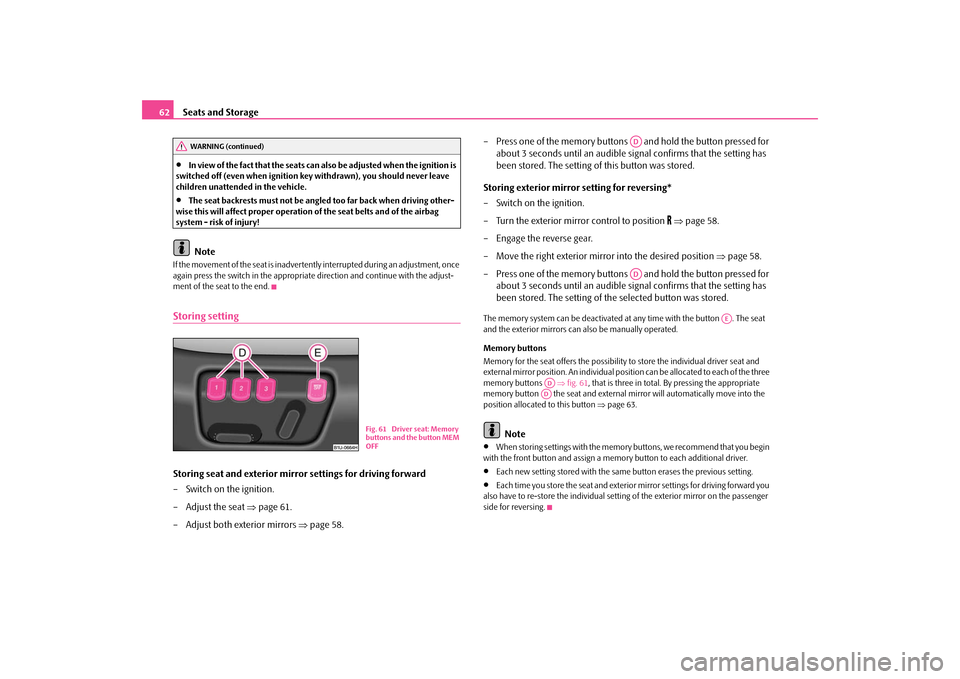
Seats and Storage
62
•
In view of the fact that the seats can
also be adjusted when the ignition is
switched off (even when ignition key withdrawn), you should never leave children unattended in the vehicle.•
The seat backrests must not be angl
ed too far back when driving other-
wise this will affect proper operation of the seat belts and of the airbag system - risk of injury!
Note
If the movement of the seat is inadverten
tly interrupted during an adjustment, once
again press the switch in the appropriate
direction and continue with the adjust-
ment of the seat to the end.Storing settingStoring seat and exterior mirror settings for driving forward – Switch on the ignition. – Adjust the seat
⇒
page 61.
– Adjust both exterior mirrors
⇒
page 58.
– Press one of the memory buttons and hold the button pressed for
about 3 seconds until an audible sign
al confirms that the setting has
been stored. The setting of this button was stored.
Storing exterior mirror setting for reversing* – Switch on the ignition. – Turn the exterior mirror control to position
⇒
page 58.
– Engage the reverse gear.– Move the right exterior mirror into the desired position
⇒
page 58.
– Press one of the memory buttons and hold the button pressed for
about 3 seconds until an audible sign
al confirms that the setting has
been stored. The setting of the selected button was stored.
The memory system can be
deactivated at any time with the button . The seat
and the exterior mirrors can also be manually operated. Memory buttons Memory for the seat offers the possibility to store the individual driver seat and external mirror position. An individual position can be allocated to each of the three memory buttons
⇒fig. 61
, that is three in total. By pressing the appropriate
memory button the seat and external mi
rror will automatica
lly move into the
position allocated to this button
⇒page 63.
Note
•
When storing settings with the memory buttons, we recommend that you begin
with the front button and assign a memory button to each additional driver.•
Each new setting stored with the same
button erases the previous setting.
•
Each time you store the seat and exterior mirror settings for driving forward you
also have to re-store the individual settin
g of the exterior mirror on the passenger
side for reversing.
WARNING (continued)
Fig. 61 Driver seat: Memory buttons and the button MEM OFF
ADAD
AE
ADAD
s2g8.b.book Page 62 Tuesday, April 7, 2009 8:53 AM
Page 64 of 224
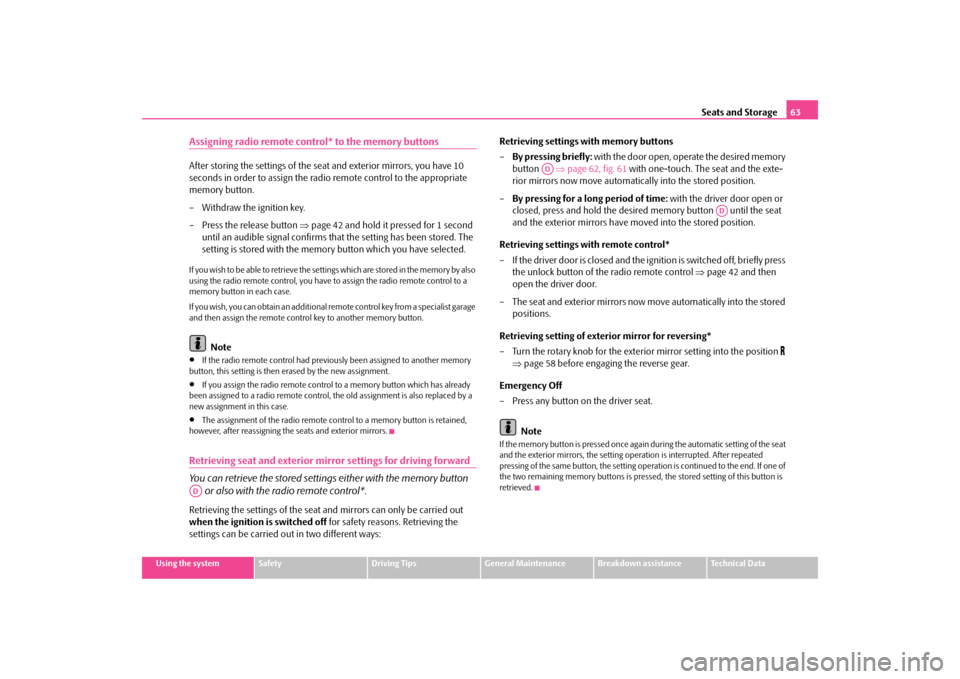
Seats and Storage
63
Using the system
Safety
Driving Tips
General Maintenance
Breakdown assistance
Technical Data
Assigning radio remote control* to the memory buttonsAfter storing the settings of the seat
and exterior mirrors, you have 10
seconds in order to assign the radio remote control to the appropriate memory button. – Withdraw the ignition key. – Press the release button
⇒
page 42 and hold it pressed for 1 second
until an audible signal confirms that the setting has been stored. The setting is stored with the memory button which you have selected.
If you wish to be able to retrieve the settings which are stored in the memory by also using the radio remote control, you have
to assign the radio remote control to a
memory button in each case. If you wish, you can obtain an additional re
mote control key from a specialist garage
and then assign the remote control key to another memory button.
Note
•
If the radio remote control had previous
ly been assigned to another memory
button, this setting is then erased by the new assignment.•
If you assign the radio remote control
to a memory button which has already
been assigned to a radio remote control,
the old assignment is also replaced by a
new assignment in this case.•
The assignment of the radio remote control to a memory button is retained,
however, after reassigning the seats and exterior mirrors.Retrieving seat and exterior mirror settings for driving forward You can retrieve the stored settings
either with the memory button
or also with the radio remote control*.
Retrieving the settings of the seat and mirrors can only be carried out when the ignition is switched off
for safety reasons. Retrieving the
settings can be carried out in two different ways:
Retrieving settings with memory buttons –
By pressing briefly:
with the door open, operate the desired memory
button
⇒
page 62, fig. 61
with one-touch. The seat and the exte-
rior mirrors now move automatically into the stored position.
–
By pressing for a long period of time:
with the driver door open or
closed, press and hold the desired memory button until the seat and the exterior mirrors have moved into the stored position.
Retrieving settings with remote control* – If the driver door is closed and the ignition is switched off, briefly press
the unlock button of the radio remote control
⇒
page 42 and then
open the driver door.
– The seat and exterior mirrors now
move automatically into the stored
positions.
Retrieving setting of exterior mirror for reversing* – Turn the rotary knob for the exterior mirror setting into the position
⇒
page 58 before engaging the reverse gear.
Emergency Off – Press any button on the driver seat.
Note
If the memory button is pressed once again
during the automatic setting of the seat
and the exterior mirrors, the setting operation is interrupted. After repeated pressing of the same button, the setting operation is continued to the end. If one of the two remaining memory buttons is pressed, the stored setting of this button is retrieved.
AD
AD
AD
s2g8.b.book Page 63 Tuesday, April 7, 2009 8:53 AM
Page 90 of 224
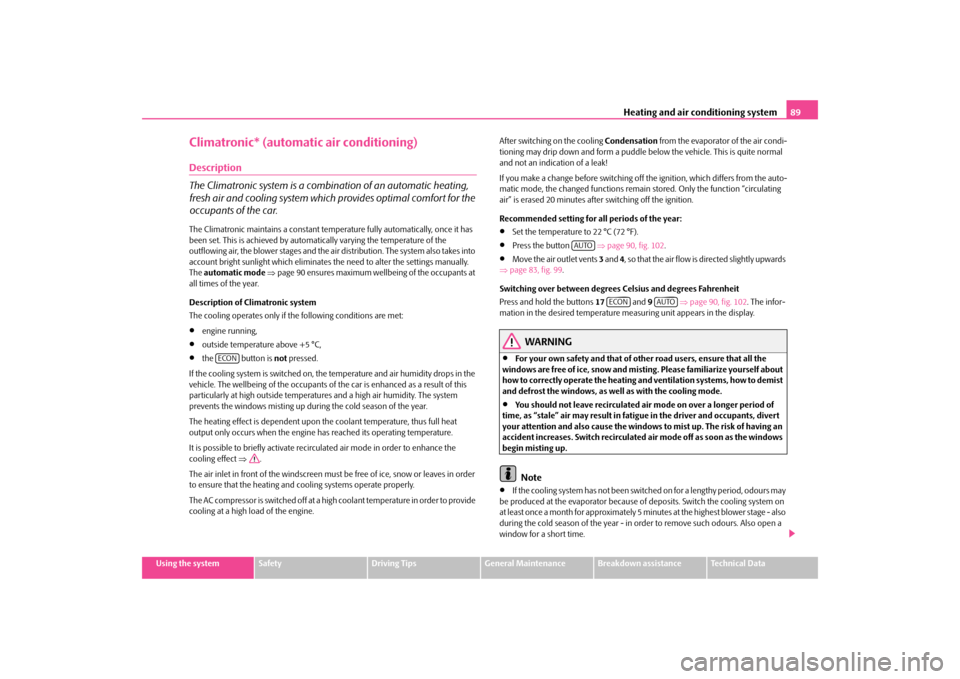
Heating and air conditioning system
89
Using the system
Safety
Driving Tips
General Maintenance
Breakdown assistance
Technical Data
Climatronic* (automatic air conditioning)Description The Climatronic system is a combin
ation of an automatic heating,
fresh air and cooling system which provides optimal comfort for the occupants of the car.The Climatronic maintains a constant temp
erature fully automatically, once it has
been set. This is achiev
ed by automatically varying the temperature of the
outflowing air, the blower stages and the ai
r distribution. The system also takes into
account bright sunlight which eliminates
the need to alter the settings manually.
The
automatic mode
⇒page 90 ensures maximum wellbeing of the occupants at
all times of the year. Description of Climatronic system The cooling operates only if the following conditions are met:•
engine running,
•
outside temperature above +5 °C,
•
the button is
not
pressed.
If the cooling system is switched on, the temperature and air humidity drops in the vehicle. The wellbeing of the occupants of
the car is enhanced as a result of this
particularly at high outs
ide temperatures and a high air humidity. The system
prevents the windows misting up during the cold season of the year. The heating effect is dependent upon th
e coolant temperature, thus full heat
output only occurs when the engine has reached its operating temperature. It is possible to briefly activate recirc
ulated air mode in order to enhance the
cooling effect
⇒
.
The air inlet in front of the windscreen must be free of ice, snow or leaves in order to ensure that the heating and cooling systems operate properly. The AC compressor is switched off at a hi
gh coolant temperature in order to provide
cooling at a high load of the engine.
After switching on the cooling
Condensation
from the evaporator of the air condi-
tioning may drip down and form a puddle be
low the vehicle. This is quite normal
and not an indication of a leak! If you make a change before switching off
the ignition, which differs from the auto-
matic mode, the changed functions remain
stored. Only the function “circulating
air” is erased 20 minutes after switching off the ignition. Recommended setting for all periods of the year:•
Set the temperature to 22 °C (72 °F).
•
Press the button
⇒page 90, fig. 102
.
•
Move the air outlet vents
3 and
4, s o t h a t th e a i r f l o w i s d i re c t e d s l i g h tl y u pw a rd s
⇒ page 83, fig. 99
.
Switching over between degrees
Celsius and degrees Fahrenheit
Press and hold the buttons
17 and
9
⇒page 90, fig. 102
. The infor-
mation in the desired temperature measuring unit appears in the display.
WARNING
•
For your own safety and that of other road users, ensure that all the
windows are free of ice, snow and mistin
g. Please familiarize yourself about
how to correctly operate th
e heating and ventilation systems, how to demist
and defrost the windows, as well as with the cooling mode.•
You should not leave recirculated air mode on over a longer period of
time, as “stale” air may result in fatigue in the driver and occupants, divert your attention and also cause the windows to mist up. The risk of having an accident increases. Switch recirculated air mode off as soon as the windows begin misting up.
Note
•
If the cooling system has not been switched on for a lengthy period, odours may
be produced at the evaporator because of
deposits. Switch the cooling system on
at least once a month for approximately 5 mi
nutes at the highest blower stage - also
during the cold season of the year - in
order to remove such odours. Also open a
window for a short time.
ECON
AUTO
ECON
AUTO
s2g8.b.book Page 89 Tuesday, April 7, 2009 8:53 AM
Page 91 of 224
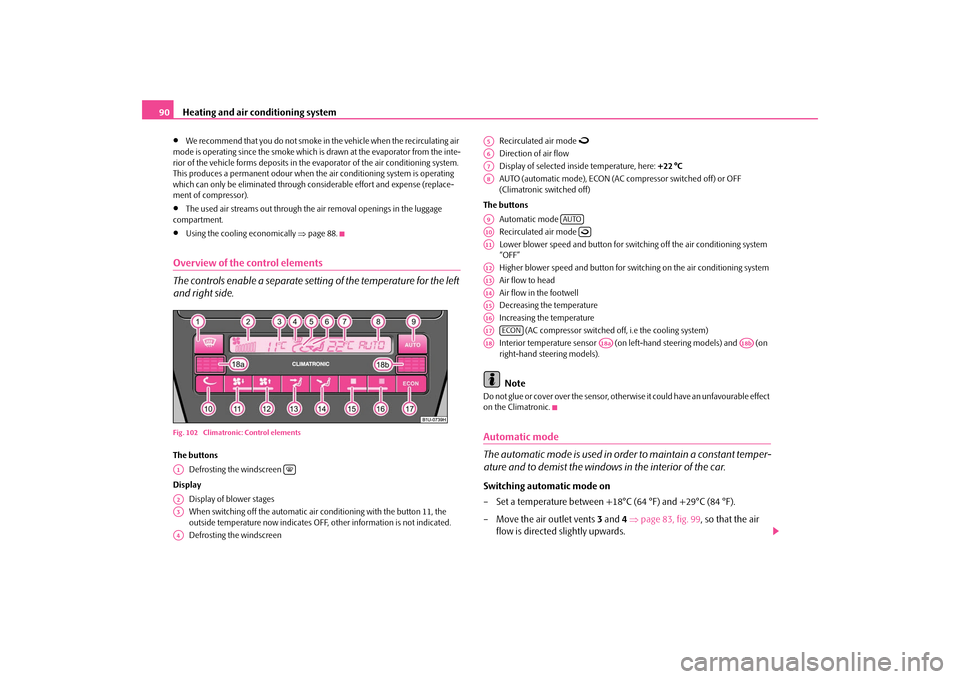
Heating and air conditioning system
90
•
We recommend that you do not smoke in the vehicle when the recirculating air
mode is operating since the smoke which is drawn at the evaporator from the inte- rior of the vehicle forms deposits in the
evaporator of the air
conditioning system.
This produces a permanent odour when the air conditioning system is operating which can only be eliminated through considerable effort and expense (replace- ment of compressor).•
The used air streams out through the air removal openings in the luggage
compartment.•
Using the cooling economically
⇒page 88.
Overview of the control elements The controls enable a separate setti
ng of the temperature for the left
and right side.Fig. 102 Climatronic: Control elementsThe buttons
Defrosting the windscreen
Display
Display of blower stages When switching off the automatic air co
nditioning with the button 11, the
outside temperature now indicates OFF, other information is not indicated. Defrosting the windscreen
Recirculated air mode
Direction of air flow Display of selected inside temperature, here:
+22 °C
AUTO (automatic mode), ECON (AC
compressor switched off) or OFF
(Climatronic switched off)
The buttons
Automatic mode Recirculated air mode Lower blower speed and button for switch
ing off the air conditioning system
“OFF” Higher blower speed and button for switching on the air conditioning system Air flow to head Air flow in the footwellDecreasing the temperature Increasing the temperature
(AC compressor switched off, i.e the cooling system)
Interior temperature sensor (on le
ft-hand steering models) and (on
right-hand stee
ring models).
Note
Do not glue or cover over the sensor, otherw
ise it could have an unfavourable effect
on the Climatronic.Automatic mode The automatic mode is used in order to maintain a constant temper- ature and to demist the windows in the interior of the car.Switching automatic mode on – Set a temperature between +18°C (64 °F) and +29°C (84 °F). – Move the air outlet vents
3 and
4 ⇒
page 83, fig. 99
, so that the air
flow is directed slightly upwards.
A1
A2A3A4
A5A6A7A8A9
AUTO
A10
A11A12A13A14A15A16A17
ECON
A18
A18a
A18b
s2g8.b.book Page 90 Tuesday, April 7, 2009 8:53 AM
Page 93 of 224
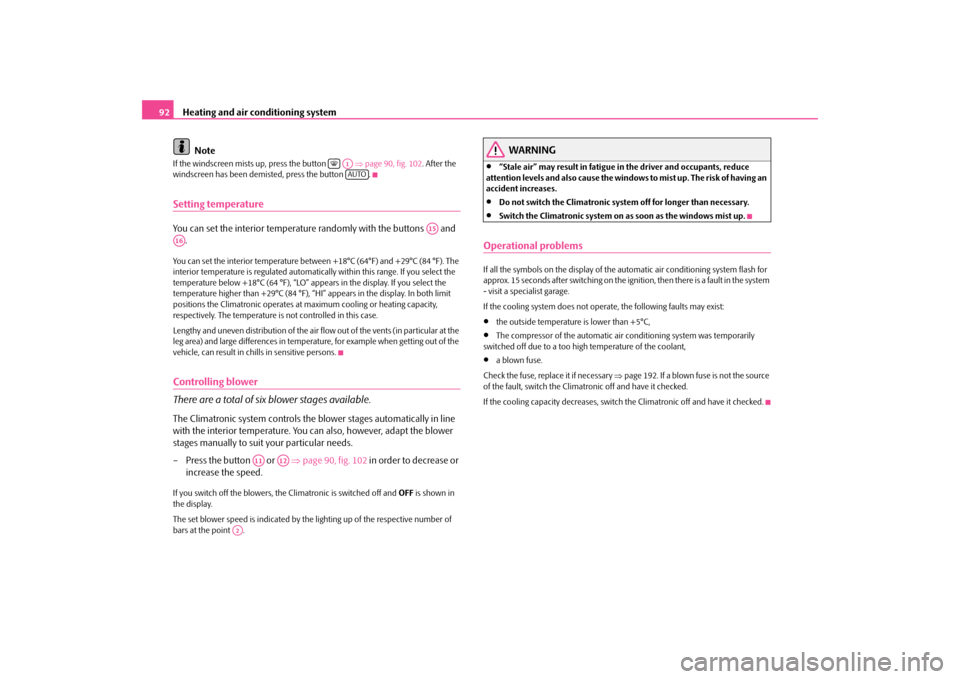
Heating and air conditioning system
92
Note
If the windscreen mists up, press the button
⇒page 90, fig. 102
. After the
windscreen has been demisted, press the button .Setting temperatureYou can set the interior temperature randomly with the buttons and
.
You can set the interior temperature between +18°C (64°F) and +29°C (84 °F). The interior temperature is regulated automatica
lly within this range. If you select the
temperature below +18°C (64 °F), “LO” appe
ars in the display. If you select the
temperature higher than +29°C (84 °F), “H
I” appears in the display. In both limit
positions the Climatronic operates at
maximum cooling or heating capacity,
respectively. The temperature is not controlled in this case. Lengthy and uneven distribution of the air flow out of the vents (in particular at the leg area) and large differences in temperature, for example when getting out of the vehicle, can result in chills in sensitive persons.Controlling blower There are a total of six blower stages available.The Climatronic system controls the bl
ower stages automatically in line
with the interior temperature. You
can also, however, adapt the blower
stages manually to suit
your particular needs.
– Press the button or
⇒
page 90, fig. 102
in order to decrease or
increase the speed.
If you switch off the blowers, th
e Climatronic is switched off and
OFF
is shown in
the display. The set blower speed is indicated by the lighting up of the respective number of bars at the point .
WARNING
•
“Stale air” may result in fatigue in
the driver and occupants, reduce
attention levels and also cause the windows to mist up. The risk of having an accident increases.•
Do not switch the Climatronic syst
em off for longer than necessary.
•
Switch the Climatronic system on as soon as the windows mist up.
Operational problemsIf all the symbols on the display of the au
tomatic air conditioning system flash for
approx. 15 seconds after switching on the ignition, then there is a fault in the system - visit a specialist garage. If the cooling system does not oper
ate, the following faults may exist:
•
the outside temperature is lower than +5°C,
•
The compressor of the automatic air
conditioning system was temporarily
switched off due to a too high temperature of the coolant,•
a blown fuse.
Check the fuse, replace it if necessary
⇒page 192. If a blown fuse is not the source
of the fault, switch the Climatronic off and have it checked. If the cooling capacity decreases, switch
the Climatronic off and have it checked.
A1AUTO
A15
A16
A11
A12
A2
s2g8.b.book Page 92 Tuesday, April 7, 2009 8:53 AM